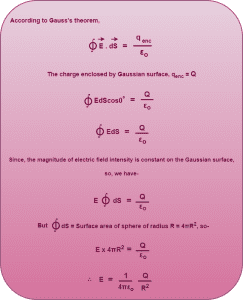Gauss’s Law-
Before you go through this article, make sure that you have gone through the previous article on Gauss’s Law.
We have learnt-
- Gauss’s Law helps to find the total electric flux through any closed surface.
- It states that the total electric flux through any closed surface is 1/εo times the net charge enclosed within it.
Applications of Gauss’s Law-
Using Gauss’s law, we will calculate the electric field due to a-
- thin infinite long line charge
- uniformly charged infinite plane sheet
- uniformly charged thin spherical shell
In this article, we will discuss the electric field due to a thin spherical shell.
Electric Field Due To A Charged Thin Spherical Shell-
Consider a positive charge Q uniformly distributed on the surface of a spherical shell of radius R.
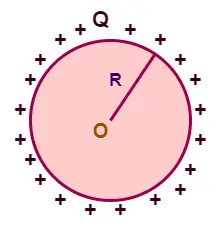
Direction of Electric Field-
The electric field due charged spherical shell is directed-
- radially outwards if the shell contains a positive charge
- radially inwards if the shell contains a negative charge
Magnitude of Electric Field-
By symmetry, the magnitude of electric field intensity is same at all points equidistant from the center of spherical shell.
To calculate the magnitude of electric field intensity E at a point P located at a distance r from the center O of spherical shell using Gauss’s law, we consider an imaginary sphere of radius r with center O as the Gaussian surface.
A spherical Gaussian surface is an ideal choice because-
- At every point on the surface of sphere, the magnitude of electric field intensity is constant.
- The angle between electric field intensity and area vector at any point on the Gaussian surface will be 0°.
There are following three cases possible-
- When observation point lies outside the shell i.e. r > R
- When observation point lies on the surface of shell i.e. r = R
- When observation point lies inside the shell i.e. r < R
Case-01: When observation point lies outside the shell (r>R)
We draw a spherical Gaussian surface of radius r (>R) with O as the center as shown-
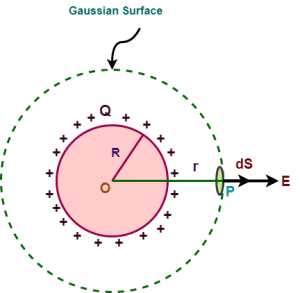

This formula resembles the Electric Field due to a Point Charge.
Important NoteElectric field intensity due to a charged spherical shell at a point outside the shell is such as if the entire charge were concentrated at the center of the sphere. |
Case-02: When observation point lies on the surface of the shell (r=R)
We draw a spherical Gaussian surface of radius r=R with O as the center as shown-

Important NoteElectric field intensity due to a charged spherical shell at any point on its surface is maximum. |
Case-03: When observation point lies inside the shell (r<R)
We draw a spherical Gaussian surface of radius r (<R) with O as the center as shown-
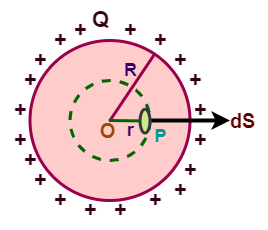

Important NoteElectric field intensity due to a charged spherical shell at any point inside the shell is zero. |
Based on the above discussion, the electric field due to charged thin spherical shell can be summarized as-
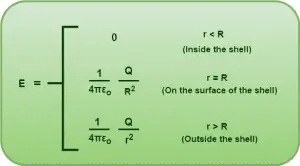
It is again worth noticing that due to a charged thin spherical shell-
- The electric field intensity at any point inside the shell is zero.
- The electric field intensity is maximum at the surface of shell.
- The electric field intensity then decreases and becomes zero at infinity.
Graph-
The following graph shows the variation of electric field intensity due to a charged thin spherical shell with distance from its center-
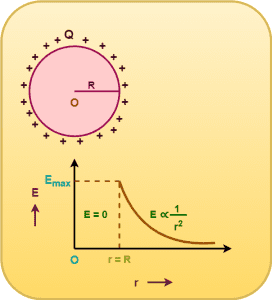
Also Check-
- Electric field due to a thin Infinite long line charge
- Electric field due to a thin infinite plane sheet of charge
Get more notes & other study material of the Chapter Electric Charges & Field.
